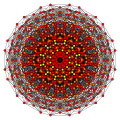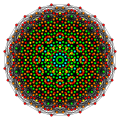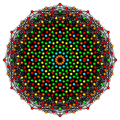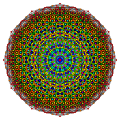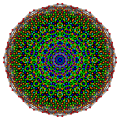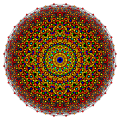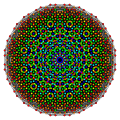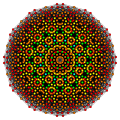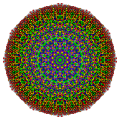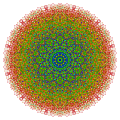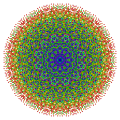Top Qs
Timeline
Chat
Perspective
7-demicube
Uniform 7-polytope From Wikipedia, the free encyclopedia
Remove ads
In geometry, a demihepteract or 7-demicube is a uniform 7-polytope, constructed from the 7-hypercube (hepteract) with alternated vertices removed. It is part of a dimensionally infinite family of uniform polytopes called demihypercubes.
E. L. Elte identified it in 1912 as a semiregular polytope, labeling it as HM7 for a 7-dimensional half measure polytope.
Coxeter named this polytope as 141 from its Coxeter diagram, with a ring on one of the 1-length branches, ![]()
![]()
![]()
![]()
![]()
![]()
![]()
![]()
![]()
![]()
![]() and Schläfli symbol or {3,34,1}.
and Schläfli symbol or {3,34,1}.
Remove ads
Cartesian coordinates
Cartesian coordinates for the vertices of a demihepteract centered at the origin are alternate halves of the hepteract:
- (±1,±1,±1,±1,±1,±1,±1)
with an odd number of plus signs.
Images
As a configuration
Summarize
Perspective
This configuration matrix represents the 7-demicube. The rows and columns correspond to vertices, edges, faces, cells, 4-faces, 5-faces and 6-faces. The diagonal numbers say how many of each element occur in the whole 7-demicube. The nondiagonal numbers say how many of the column's element occur in or at the row's element.[1][2]
The diagonal f-vector numbers are derived through the Wythoff construction, dividing the full group order of a subgroup order by removing one mirror at a time.[3]
Related polytopes
There are 95 uniform polytopes with D6 symmetry, 63 are shared by the B6 symmetry, and 32 are unique:
Remove ads
References
External links
Wikiwand - on
Seamless Wikipedia browsing. On steroids.
Remove ads












